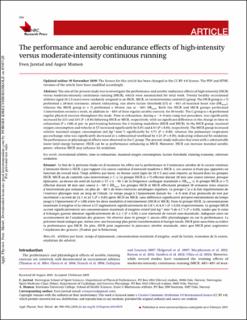| dc.contributor.author | Jarstad, Even | |
| dc.contributor.author | Mamen, Asgeir | |
| dc.date.accessioned | 2020-05-08T09:32:08Z | |
| dc.date.available | 2020-05-08T09:32:08Z | |
| dc.date.created | 2019-10-07T07:04:59Z | |
| dc.date.issued | 2019 | |
| dc.identifier.citation | Applied Physiology, Nutrition and Metabolism. 2019, 44(9), 990-996. | en_US |
| dc.identifier.issn | 1715-5312 | |
| dc.identifier.uri | https://hdl.handle.net/11250/2653709 | |
| dc.description | This work is licensed under a Creative Commons Attribution 4.0 International License (CC BY 4.0), which permits unrestricted use, distribution, and reproduction in any medium, provided the original author(s) and source are credited. | en_US |
| dc.description.abstract | The aim of the present study was to investigate the performance and aerobic endurance effects of high-intensity (HICR) versus moderate-intensity continuous running (MICR), which were nonmatched for total work. Twenty healthy recreational athletes (aged 28 ± 5 years) were randomly assigned to an HICR, MICR, or no-intervention control (C) group. The HICR group (n = 7) performed a 20-min strenuous, almost exhausting, run above lactate threshold (LT) at ∼88% of maximal heart rate (HRmax), whereas the MICR group (n = 7) performed a 40-min run at ∼80% HRmax. Both the HICR and MICR groups performed 3 intervention sessions a week, in addition to ∼60% of their regular aerobic exercise, for 10 weeks. The C group (n = 6) performed regular physical exercise throughout the study. Time to exhaustion, during a ∼4–8-min ramp test procedure, was significantly increased by 23% and 24% (P < 0.01) following HICR or MICR, respectively, with no significant difference in the change in time to exhaustion (P = 1.00) at pre- to post-training between the 2 training modalities (HICR and MICR). In the HICR group, maximal oxygen consumption and velocity at LT increased significantly by 5.0% and 6.8% (P < 0.01), respectively. The MICR group increased relative maximal oxygen consumption (mL·kg−1·min−1) significantly by 4.7% (P < 0.05), whereas the pulmonary respiratory gas-exchange ratio was significantly decreased at a submaximal workload by 4.2% (P < 0.01), indicating enhanced fat oxidation. No performance or physiological effects were observed in the C group. The present study indicates that even with a substantially lower total energy turnover, HICR can be as performance enhancing as MICR. Moreover, HICR can increase maximal aerobic power, whereas MICR may enhance fat oxidation. | en_US |
| dc.language.iso | eng | en_US |
| dc.subject | recreational athletes | en_US |
| dc.subject | time to exhaustion | en_US |
| dc.subject | maximal oxygen consumption | en_US |
| dc.subject | lactate threshold | en_US |
| dc.subject | running economy | en_US |
| dc.subject | substrate oxidation | en_US |
| dc.title | The performance and aerobic endurance effects of high-intensity versus moderate-intensity continuous running | en_US |
| dc.type | Peer reviewed | en_US |
| dc.type | Journal article | en_US |
| dc.description.version | publishedVersion | en_US |
| dc.rights.holder | Copyright remains with the author(s) or their institution(s). | en_US |
| dc.source.pagenumber | 990-996 | en_US |
| dc.source.volume | 44 | en_US |
| dc.source.journal | Applied Physiology, Nutrition and Metabolism | en_US |
| dc.source.issue | 9 | en_US |
| dc.identifier.doi | 10.1139/apnm-2018-0575 | |
| dc.identifier.cristin | 1734269 | |
| dc.description.localcode | Seksjon for fysisk prestasjonsevne / Department of Physical Performance | en_US |
| cristin.ispublished | true | |
| cristin.fulltext | original | |
| cristin.qualitycode | 1 | |
